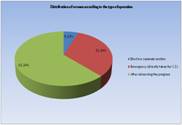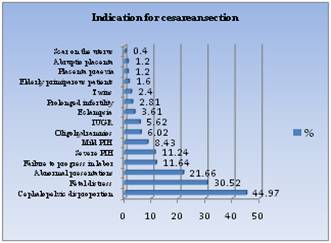 |
|||||||||||||||||||||||||||||||||||||||||||||||||||||||||||||||||||||||||||||||||||||||||||||||||||||||||||||||||||||||||||||||||||||||||||||||||||||||
|
|
|||||||||||||||||||||||||||||||||||||||||||||||||||||||||||||||||||||||||||||||||||||||||||||||||||||||||||||||||||||||||||||||||||||||||||||||||||||||
 |
|||||||||||||||||||||||||||||||||||||||||||||||||||||||||||||||||||||||||||||||||||||||||||||||||||||||||||||||||||||||||||||||||||||||||||||||||||||||
|
|
[Abstract] [PDF] [HTML] [Linked References]
A Study of Various Indication of Caesarian Section in Primiparous Patients
Nitin Naresh Kulkarni1*, Laxmikant R. Kanade2 1Lecturer, 2Associate Professor, Department of OBGY, A.C.P.M. Medical College, Dhule, Maharashtra, INDIA. *Corresponding Address: Research Article
Abstract: Introduction: The indications for cesarean section in primiparous patients are changing day-to-day and newer indications are being added to it. This is because in modern obstetrics with the increasing amenities. Cesarean section may be required at first or second stage of labor. With all practical variations, it is the most essential procedure for the well-being of mother and fetus. Aims and Objectives: To find out the various indications for cesarean section in primiparous patients attending the tertiary care institute for delivery. Material and Methods: The present study was conducted at ACPM Medical College and Hospital, Dhule. All the primiparous women attending the institute for the delivery and undergone cesarean section were enrolled in the study. Detail clinical examination and required investigations were done and the precise indication for cesarean section was decided and noted down. Results: Most common age group was young between 15 to 25 years. 62.24% cases were taken for cesarean section after observing the progress i.e. in the form of fetal distress, cervical dystocia, prolonged labor etc. Cephalopelvic disproportion (44.97) was the most common indication for cesarean section followed by fetal distress (30.52%). PIH was the indication in 19.67% cases. An abnormal presentation was reported in 21.66% cases. Elderly primiparous patients, prolonged infertility and ant epartum hemorrhage were present in very few women. Conclusion: cephalopelvic disproportion was the most common indication for cesarean section in primiparous women followed by fetal distress, abnormal presentation, PIH and failure to progress.
Introduction Throughout the history of mankind many primiparous patients have dashed the hopes of a successful labour due to a variety of causes. Lay people and experts alike have witnessed so many impediments in a primiparous woman that on delivery of the patient, the relations, the accoucheur all feel as if the parturient has been reborn. The struggle between various maladies of labour and the ceaseless efforts made generation after generation by obstetricians to overcome it is heroic indeed. Delivering the parturient abdominally by cesarean section was fraught with a very high maternal and perinatal mortality and morbidity. Now with the increased safety of cesarean section due to better anesthesia, antibiotics, blood transfusion facilities, improved techniques, accoucheur’s great desire to deliver the child without damage, the risk is very small. The incidence of this mode of delivery is therefore constantly rising, from 4 percent1 (1968) to nearly 15-25 percent2 in primiparous patients today. The indications for cesarean section in primiparous patients are changing day-to-day and newer indications are being added to it. This is because in modern obstetrics with the increasing amenities for diagnosis like, ultrasound, electronic fetal monitoring and fetal scalp blood sampling, the obstetrician is progressively liberal in choosing this mode of delivery. Cesarean section may be required at first or second stage of labor. With all practical variations, it is the most essential procedure for the well-being of mother and fetus. The inevitable was predicted in 1948 by D‘Espo,3 saying that, “the matter of cesarean section rate will be of consequent interest in 5 to 10 years, for there appears now to be a definite tendency to broaden the indications, the greater safety of operation makes it obvious”. No more difficult and traumatic mid cavity forceps, no more destructive operations, but a safe delivery of live foots with minimum material morbidity. Now cesarean section is the operation of necessity in many primiparous patients of antepartum hemorrhage, high risk pregnancy, cephalopelvic disproportion, fetal distress and elderly primi. Contributing factors to increase cesarean section rate are better antenatal care, advances in fetal monitoring and prompt resuscitation of the new born.
Aims and Objectives To find out the various indications for cesarean section in primiparous patients attending the tertiary care institute for delivery.
Material and Method Study Design The present study was conducted at ACPM Medical College and Hospital, Dhule. All the primiparous women attending the institute for the delivery were enrolled in the study. Study duration: April 2013 to March 2014.
Methodology With respect to following inclusion and exclusion criterion study population was selected. Inclusion Criteria
Exclusion Criteria
Thus total one thousand primiparous women attended the institute for delivery and out of that 249 women undergone cesarean section for various indications. These cases include registered as well as referred cases. Information regarding age, height, ANC registration and other obstetrics findings were recorded. Associated significant obstetric and past history was noted. Detail clinical examination and required investigations were done and the precise indication for cesarean section was decided and noted down. In some cases multiple indications were observed.
Results Table 1: Age wise distribution of women
Majority i.e. 91.55% of patients were between 15 to 25 years. 4 were elderly primiparous patients.
Table 2: Distribution of women according to the type of operation
It was observed that only 14 (5.62%) cases had elective cesarean while remaining 235 cases were divided into two groups. First group includes the cases which were directly taken for cesarean section on admission. It consists of 32.14% cases. Second group consist of Cases taken for cesarean section after observing the progress of labor i.e. in the form of fetal distress, cervical dystocia, prolonged labor, etc. and it consist of 62.24% cases.
Table 3: Distribution of women according to associated significant obstetric and past history.
Out of 249 cases, 7 were having long standing infertility. 15 patients were having history of previous abortions. Rh negative patients were 14. Majority of patients were having mild to severe PIH i.e. 49 cases. There were 4 elderly primiparous patients, one patient had previous hysterotomy scar on the uterus and 3 patients were of heart disease. Thus PIH contributed a major factor for cesarean in primi.
Table 3: Distribution of women according indications for cesarean sections.
*multiple responses were obtained
Various indications for the cesarean section among the study population were studied. It was observed that in some women multiple indication for cesarean section were present. It was observed that cephalopelvic disproportion (44.97%) was the most common indication for cesarean section in primis followed by fetal distress (30.52%) and abnormal presentation (21.66%). Obstructed labor (18 cases) was the major cause fatal distress in the study. Breech presentation (34 cases) was the most common cause among the abnormal presentation category. Two cases were with face presentation. PIH was the indication for casern section in 49 cases.
Discussion The present study was carried out on 249 primiparous patients who had undergone cesarean section admitted in this institute during the period of one year (FEB. 2002 to Dec. 2002). The aim was to study the various indications of cesarean section in primiparous women attending the institute for delivery. In the present study, the age incidence ranged from 15 to 34 years. The youngest patient was of 15 years. There were 4 elderly primiparous patients having age above 30 years. It was also seen that 91.55 percent of cases were between 15 to 25 years. This can be explained on the basis of early marriages in our country and consequently early child-bearing. In 62.24% cases efforts were taken for normal delivery. But when the progress of labor was not satisfactory then decision was taken. Various reasons were present for unsatisfactory progress of labor such as fetal distress, cervical dystocia, prolonged labor, etc. Women with significant obstetric and past history require judicious attention in their management. In the present study out of 249 women 93 (37.32%) were having either significant obstetric or past history. It was observed that PIH and past history of abortion were the most common condition associated in the study population.
In the majority of cases more than one indication for cesarean section was present i.e. 185 (74.29%) patients. While in 64 (25.71%) patients, there was only one indication. In the present study cephalopelvic disproportion was present, in 44.97% cases and was the commonest indication for cesarean section. Arora from JIPMER4 in his study found that in 20.2% cases cephalopelvic disproportion was the reason for cesarean section. Vijaykumar and Rawal5 (30.4%), S.N.Daftary2 (24.3%) also found low incidence of cephalopelvic disproportion in their study. Rajgopalan1 (48.8%), Jatiswar Singh5 (44.4%), H.Konar6 (38.84%) proved that in primiparous patients, cephalopelvic disproportion was the commonest indication for cesarean section which contributes 48.8 percent. This correlates with our study. The incidence of cesarean section for fetal distress in present series is 30.52%. In the study by O’Driscol7 et al (1969) the incidence was 10 percent. It shows there is definite rise in the cesarean section rate for fetal distress. As more attention is given to reduce fetal and perinatal mortality and fetal monitoring has improved. This leads to early diagnosis of fetal distress. In 1998 S.N.Daftary2 in his study found 27.1% cases of fetal distress which correlate with our study. Abnormal presentations, contributes 30% cases in the study done by O’Driscol7. In present study, it was 21.68%. It includes breech 13.65%, face presentation 0.80, persistent occipito-posterior position 2.4%, transverse lie 2.81% and cord prolapse 2.02%. The use of cesarean section in these cases was to avoid traumatic vaginal manipulations and to decrease the perinatal mortality. Similar findings were stated by Green J et al8 and Cohen et al9. PIH in primiparous patients who were taken up for cesarean section was present in 19.67%. It was many times associated with other factors which needed cesarean section. It was rarely per se the indication for cesarean section unless in the very severe cases as of impending eclampsia. 29 (11.64%) cases were taken up for cesarean section because of failure to progress in labor. They were associated with cervical dystocia, minor degree cephalopelvic disproportion and other causes. Amongst the remaining cases 4(1.60%) were elderly primiparous patients, more than 30 years of age. 7 (2.81%) cases were having prolonged infertility and other associated factors like fetal distress, PIH and the like. 14 (5.62%) cases having intrauterine growth restricted babies needed cesarean section for fetal distress. 1(0.40%) case was taken up for cesarean section for previous doubtful hysterotomy scar.
Conclusion Thus in the end we can conclude that cephalopelvic disproportion was the most common indication for cesarean section in primiparous women followed by fetal distress, abnormal presentation, PIH and failure to progress. Elderly primiparous patients, prolonged infertility and antepartum hemorrhage were present in very few women.
Acknowledgement We express our sincere gratitude to Staff of OBGY Department, ACPM Medical College and Hospital, Dhule for the whole hearted support and co-operation without which this venture would not have materialized.
References
|
||||||||||||||||||||||||||||||||||||||||||||||||||||||||||||||||||||||||||||||||||||||||||||||||||||||||||||||||||||||||||||||||||||||||||||||||||||||
|
|||||||||||||||||||||||||||||||||||||||||||||||||||||||||||||||||||||||||||||||||||||||||||||||||||||||||||||||||||||||||||||||||||||||||||||||||||||||

